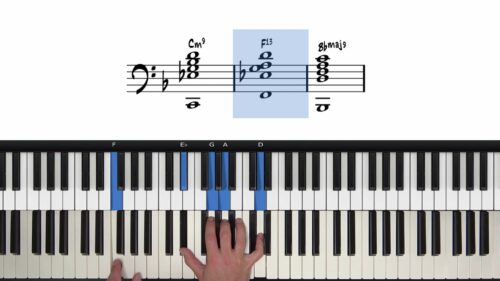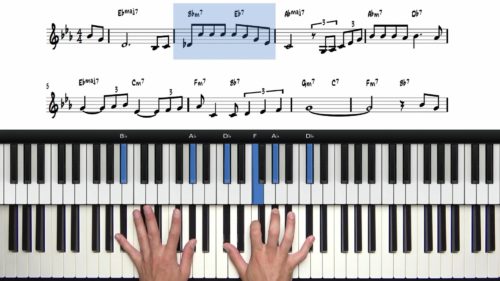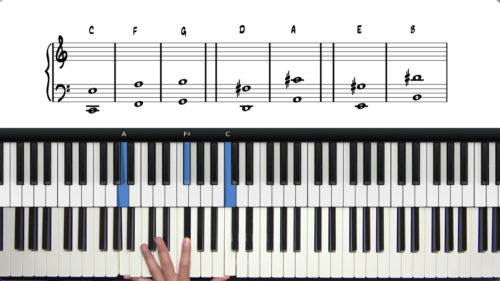Octave Melody Stride – ‘Body & Soul’ (B Section)
Welcome to the final lesson on the B section of ‘Body & Soul’, where we explore an octave melody stride piano style.
In the previous lessons, we worked with simple voicings using roots, 3rds, and 7ths, and then introduced chord extensions and upper structure triads to add color and texture.
We will now expand on this by incorporating a two-handed stride technique that brings richness and depth to the arrangement.
Mastering the Stride Left Hand
Stride piano is characterized by an alternating bass and chord movement, creating a driving pulse in the left hand. We start by isolating the left hand, focusing on playing 10th intervals and the chord tones in the higher registers. The left hand 10th interval creates a fuller, more expansive sound that enhances the foundations of the stride left hand style.
The chord progression in the final section follows:
- D-7 → G7
- E-7 → Eb°7
- D-7 → G7
- Descending chromatic dominant chords leading back to the final A section.
Practicing the left-hand stride independently ensures a solid foundation before adding the melody. If your hands struggle to reach a full 10th, ‘rolling’ the notes can add an interesting texture while maintaining the stride feel.
Adding the Melody
Once the left hand is steady, the next step is to introduce the melody. Start with a single-note melody to internalize the phrasing before moving to more advanced techniques.
To build intensity, play the melody in octaves. This increases the impact and helps the melody ‘sing’ over the stride accompaniment.
Embellishing with Chord Tones
The final step is to enhance the melody by filling in chord tones within the octave. These additional notes should be chosen carefully to maintain an even spread within the octave shape, ensuring a balanced and resonant sound. Typically, these are:
- Chord tones (root, 3rd, 5th, 7th)
- Extensions (9ths, 11ths, and 13ths) when appropriate
- Upper structure triads for a fuller sound
For example, on a G7 chord, rather than playing just a basic 5th and 7th, substituting an E major triad (an upper structure of G7) provides a richer harmonic texture.
Structuring the B Section for Contrast
This stride technique works particularly well in the second line of the B section. A recommended approach is to play a single-note melody for the first line of the B section and then introduce the stride style in the second half. This creates a dynamic contrast that adds interest and variation to the performance.
This style closely resembles the solo piano approach of Beegie Adair, whose recordings offer excellent examples of lush, stride-based jazz ballad interpretations.
Practice Tips
-
Master the Left Hand First – Ensure you can play the 10th intervals smoothly before adding the melody.
-
Build in Layers – Start with a single-note melody, then progress to octaves, and finally add chord tones for a fuller sound.
-
Experiment with Rhythmic Anticipation – Slightly anticipating the left-hand chords can create more interest in the left hand.
-
Use Upper Structure Triads – Try integrating these for a richer harmonic texture in dominant chords.
- Create Contrast – Use a single-note melody in the first half of the B section and bring in the stride technique in the second half for variation.






